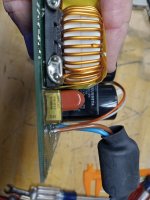dtih
Experienced Member
I've had this VAX since 2001 and over time I installed more memory and 2 RF73 DSSI disks, it came with a TF85 tape drive. I installed VMS in 2001, last time I powered it up wa 2016. It was running just fine, except for a smell it would begin generating.
Powered it on the other day and passes POST tests.
KA675-A V4.8, VMB 2.12
Performing normal system tests.
66..65..64..63..62..61..60..59..58..57..56..55..54..53..52..51..
50..49..48..47..46..45..44..43..42..41..40..39..38..37..36..35..
34..33..32..31..30..29..28..27..26..25..24..23..22..21..20..19..
18..17..16..15..14..13..12..11..10..09..08..07..06..05..04..03..
Tests completed.
However, none of the disks spin up (the led's on the drives light up temporarily, then go dark)
>>>show dssi
DSSI Bus 0 Node 6 (*)
DSSI Bus 1 Node 7 (*)
It doesn't even see the tape drive!
Here is what I've done:
1. Remove and reseat all drives, cpu, memory and power supply.
2. Measure voltages at TF85 drive, 12V OK, 5V OK.
3. Replace 2 RIFA capacitors in the H7864 power supply. (thanks to Aaron Jackson for his site - https://aaronsplace.co.uk/blog/2018-06-04-vax-4000-power-supply.html ) Smell is gone!
4. Put Qbus minimum load board back in.
Have I crossed the Rubicon with DSSI devices? Is there any hope?
Powered it on the other day and passes POST tests.
KA675-A V4.8, VMB 2.12
Performing normal system tests.
66..65..64..63..62..61..60..59..58..57..56..55..54..53..52..51..
50..49..48..47..46..45..44..43..42..41..40..39..38..37..36..35..
34..33..32..31..30..29..28..27..26..25..24..23..22..21..20..19..
18..17..16..15..14..13..12..11..10..09..08..07..06..05..04..03..
Tests completed.
However, none of the disks spin up (the led's on the drives light up temporarily, then go dark)
>>>show dssi
DSSI Bus 0 Node 6 (*)
DSSI Bus 1 Node 7 (*)
It doesn't even see the tape drive!
Here is what I've done:
1. Remove and reseat all drives, cpu, memory and power supply.
2. Measure voltages at TF85 drive, 12V OK, 5V OK.
3. Replace 2 RIFA capacitors in the H7864 power supply. (thanks to Aaron Jackson for his site - https://aaronsplace.co.uk/blog/2018-06-04-vax-4000-power-supply.html ) Smell is gone!
4. Put Qbus minimum load board back in.
Have I crossed the Rubicon with DSSI devices? Is there any hope?


